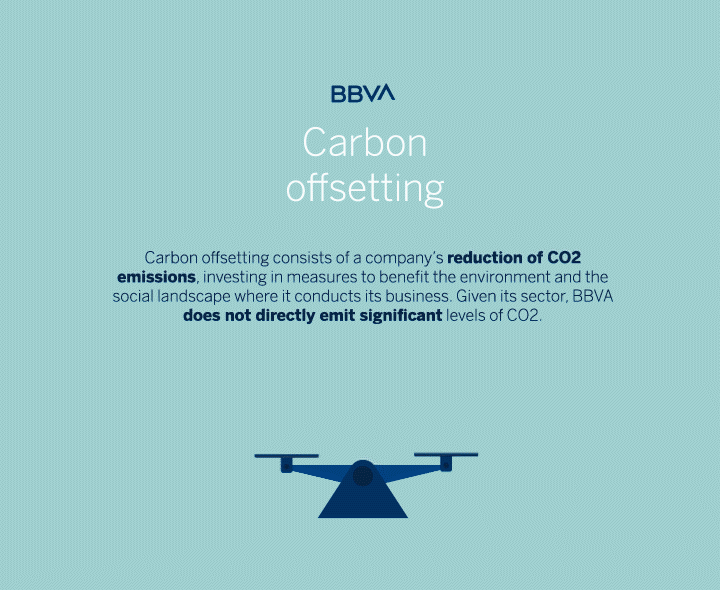As of January 1st, BBVA set an internal price for its CO2 emissions and commits to being carbon neutral in 2020
BBVA is celebrating the World Day for Reducing CO2 Emissions by reaffirming its environmental policy to develop a more sustainable economy. BBVA has committed to be neutral in terms of CO2 emissions in 2020. As of January 1st, it has assigned an internal price for its emissions, thus incorporating this factor into decision-making processes, as BBVA Group Executive Chairman Carlos Torres Vila recently announced. This measure is part of BBVA’s broader effort to align its activity with the Paris Agreement and cut its direct and indirect emissions. BBVA will light its Madrid headquarters building in blue in commemoration of this international day.

Carbon neutrality is achieved applying a combination of measures aimed at offsetting the amount of carbon dioxide (CO2) released into the atmosphere, thus bringing the overall emission balance to zero. This is also known as a net zero carbon footprint. The optimal way to strike this balance is by not emitting more CO2 than nature can absorb. There are currently two defined models that companies —like BBVA— and institutions use to reduce their carbon footprint: reduction and, when this is not possible, offsetting.
Model for the direct reduction of CO2 emissions
The most environmentally advisable model is directly reducing CO2 emissions. It is a better solution than carbon offsetting, as there is no direct pollution. It is more important to reduce emissions that to subsequently offset them. BBVA is committed to this and as of January 1, 2020, assigned an internal price to its carbon emissions, which will be incorporated into the bank’s decision-making, planning and budgeting processes. It’s an innovative procedure that will force each area to plan for the CO2 cost of each of their activities, thus encouraging emission reduction. Every area —and every employee— will have greater awareness because this cost of CO2 emitted by their department (in travel, for example) will be internally assigned to each area’s budget. This initiative joins the bank’s Global Eco-efficiency Plan, which for the past two years has promoted energy efficiency measures for BBVA’s buildings, the use of renewable energy, collective and shared transportation (shuttles) for employees, as well as videoconferences to avoid travel.

Carbon offsetting model
In addition to carbon reduction, there is also a complementary model of carbon offsetting. Based on the premise “first reduce what you can, then offset the rest,” offsetting can be achieved by voluntarily paying an amount that is proportional to the tons of CO2 generated —Global Eco-efficiency Plan buying carbon offsets or carbon credits—while also investing in projects like planting trees that absorb a certain number of tons of CO2.
Carbon offsetting projects only make environmental sense if they are preceded by previous action to reduce carbon emissions and have a positive impact on the environment. BBVA also uses offsetting for those CO2 emissions is has not yet reduced or eliminated.
A comprehensive approach to sustainability challenges
In 2015, BBVA set the goal of achieving maximum energy efficiency and the lowest environmental impact in its buildings and offices around the world. On a global scale, BBVA reduced its energy consumption per person by seven percent from January 2016 through December 2018, and 35 percent of its energy comes from renewable sources. As of December 2018, CO2 emissions had reduced 27 percent compared to 2015.

BBVA lights its Madrid headquarters building in blue in commemoration of this international day.
From 2015 to 2018 (the most recent data available), in Spain alone, BBVA has prevented the emission of over 12,000 tons of carbon dioxide (CO2) into the atmosphere. This was possible thanks to 800 different energy-saving measures using artificial intelligence and so-called green algorithms, among other things. These technologies foster more efficient lighting and climate control in the bank’s headquarters and branches. BBVA City, for example, currently uses 15 percent less energy than it did when it was first opened in 2015, and the action taken has made it possible to reduce annual CO2 emissions by 1,430 tons.
Besides being one of the founding banks of the Principles for Responsible Banking promoted by the United Nations, BBVA has joined the Collective Commitment to Climate Action launched by 31 international financial institutions. The purpose of this commitment is to align its products and services with a collective strategy in the face of the climate crisis. Thus, its signatories pledge to align their portfolios to the Paris Agreement “to reflect and finance the low-carbon economy, required to keep global warming under the two degree threshold, and make an effort to limit it to 1.5ºC." For financial institutions, due to their activity, it is the emissions generated by its customers wherein lies most of their impact in terms of carbon emissions. The United Nations considers this to be the “broadest climate-related commitment promoted within the financial industry to date.”
The energy saving actions that gain visibility as part of the World Day to Reduce CO2 Emissions are designed to fulfill the United Nations Sustainable Development Goals (SDGs). Specifically, SDGs seven (access to affordable and sustainable energy), 12 (ensure sustainable consumption and production patterns) and 13 (take urgent action to combat climate change and its effects).